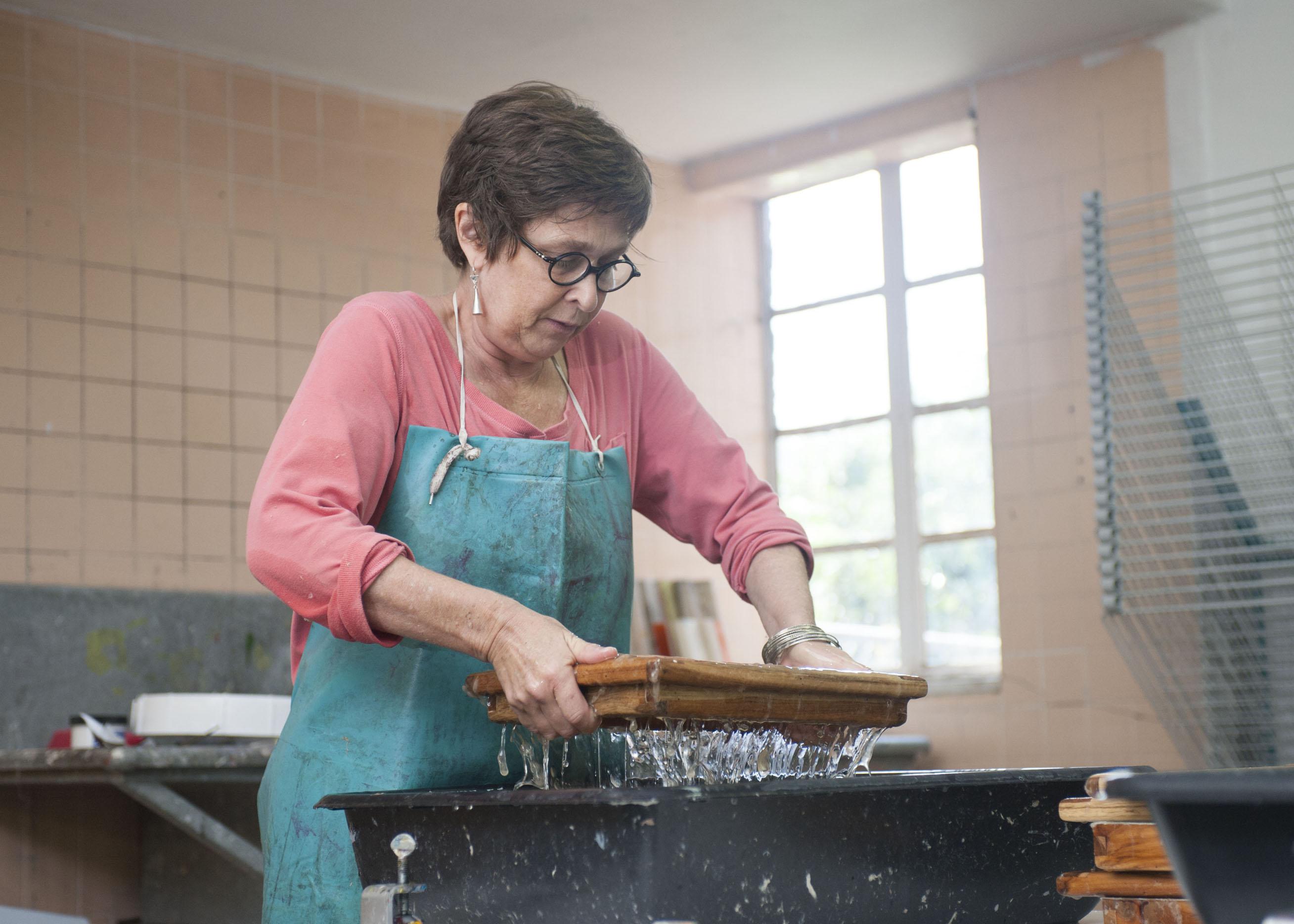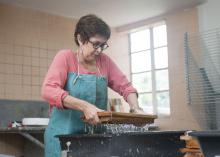Information Possibly Outdated
The information presented on this page was originally released on September 13, 2012. It may not be outdated, but please search our site for more current information. If you plan to quote or reference this information in a publication, please check with the Extension specialist or author before proceeding.
Fiber artist shares process with students
MISSISSIPPI STATE – Mississippi State University students recently discovered making paper is a noisy, messy and creative activity.
Internationally known fiber artist Mary Hark, a professor at the University of Wisconsin-Madison, came to MSU’s campus to teach art and fashion students about the beauty and versatility of handmade paper.
Hark’s hands-on papermaking workshop showcased the role of regional materials in making fiber art. Her work, along with that of fellow fiber artist Nnenna Okore of Nigeria, is on display through Oct. 3 at MSU’s Visual Arts Center Gallery in an exhibit titled “Inside-Out, Outside-In: African-Inspired Fiber Arts.”
Charles Freeman, assistant professor in MSU’s School of Human Sciences, worked with Suzanne Powney, professor of graphic design and letterpress in the College of Architecture, Art and Design to create this collaborative learning opportunity. The event also celebrated this year’s Maroon Edition book selection, “Unbowed: A Memoir,” by Kenyan activist Wangari Maathai.
“Mary wanted to use local resources to create paper with regional flair, and Caroline Jordan, a senior in the Apparel, Textiles and Merchandising program from Yazoo City, talked to her father, who is a cotton producer,” Freeman said. “The generosity of Mr. Jordan and the Delta Council in donating cotton mote, lint and bolls allowed us to build a bridge between the College of Agriculture and Life Sciences and the College of Architecture, Art and Design in a new way.”
Freeman said tying agriculture to the arts is an important experience for the students.
“They are taking a local raw material and turning it into fine art using a traditional process,” he said. “It’s opening their eyes to the potential uses of paper in design and in the fashion world.”
The multi-step process began with students breaking down wet imported Japanese mulberry fibers with pieces of two-by-fours. Outside, a mechanical Hollander beater turned cotton into pulp. From these basic materials, students used a mold and deckle to screen the pulp, flatten it and reduce its water content.
To create their paper art, workshop participants embedded into the bottom layer of pulp a variety of natural and found objects, including sticks, seeds, flower petals and berries. They laid linen string on the pulp to give the paper structure and link all of the finished pieces together. After they covered the design with a top layer of pulp, the pieces were placed in a press between felt to bind the fibers together.
“The pulp will shrink around the objects tightly and create some very interesting visual statements,” Hark said. “We’ll tie all of the pages together and add this collaborative art project to the gallery show.”
Lydia Thompson, head of the Department of Art, said this project highlights art’s role at the university and in the community.
“Art is all about communicating and collaborating,” she said. “Art is a visual depiction of the human condition -- visual aids to what people are doing on campus. We love the process and want to be inclusive of the university’s mission and programs. MSU is the people’s university, and this workshop brings together people from different parts of the university.”
Lori Neuenfeldt, lecturer and programs coordinator for the art gallery, said Hark’s exhibit, lecture and workshop gave students a closer look at the life and work of a contemporary artist.
“It’s one thing to see images and products. Process is a whole new dimension,” she said. “Our students got to work alongside Mary with tactile objects, and the end result is a collaborative work of art on display at the gallery beside artists who are internationally known and respected. That is how we want to use our space.”
The Visual Arts Center Gallery is located on University Drive and is open Tuesday through Friday from 10 a.m. to 4 p.m. and Saturday from 2 to 4 p.m.





